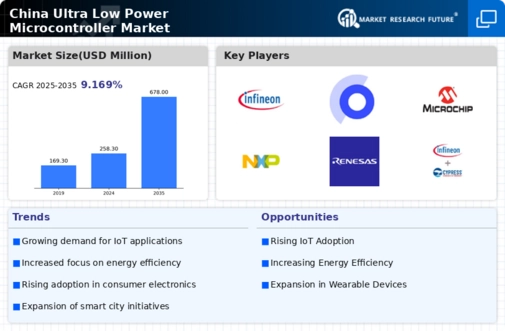Rise of Wearable Technology
The wearable technology sector in China is experiencing rapid growth, driven by consumer demand for health monitoring and fitness tracking devices. This surge in popularity is propelling the ultra low-power-microcontroller market, as these devices require microcontrollers that can operate efficiently for extended periods without frequent recharging. By 2025, the wearable technology market in China is expected to surpass $30 billion, creating a substantial opportunity for manufacturers of ultra low-power microcontrollers. These microcontrollers must not only be energy-efficient but also compact and capable of supporting advanced functionalities such as Bluetooth connectivity and real-time data processing. As a result, the ultra low-power-microcontroller market is poised for significant growth, fueled by the increasing adoption of wearable devices.
Growing Adoption of Smart Devices
The increasing proliferation of smart devices in China is a key driver for the ultra low-power-microcontroller market. As consumers and industries alike embrace smart technologies, the demand for microcontrollers that can operate efficiently with minimal power consumption rises. In 2025, it is estimated that the number of smart devices in China will exceed 1 billion, creating a substantial market for ultra low-power solutions. This trend is further fueled by the government's push for smart city initiatives, which necessitate the deployment of energy-efficient devices. Consequently, manufacturers are focusing on developing microcontrollers that not only meet performance requirements but also adhere to stringent energy consumption standards. This market is thus positioned to benefit significantly from this growing adoption of smart devices across various sectors.
Expansion of the Automotive Sector
The automotive sector in China is undergoing a transformation, with a notable shift towards electric vehicles (EVs) and advanced driver-assistance systems (ADAS). This transition is creating a burgeoning demand for ultra low-power microcontrollers, which are essential for managing various functions in modern vehicles. In 2025, it is projected that the EV market in China will reach a valuation of over $200 billion, necessitating the integration of energy-efficient microcontrollers to optimize performance and battery life. The ultra low-power-microcontroller market is likely to benefit from this expansion, as automotive manufacturers seek to enhance vehicle efficiency while meeting regulatory requirements for emissions and energy consumption. This trend underscores the critical role of microcontrollers in the future of automotive technology.
Government Initiatives for Energy Conservation
Chinese government policies aimed at energy conservation and sustainability are significantly influencing the ultra low-power-microcontroller market. The government has implemented various regulations and incentives to promote energy-efficient technologies, which include funding for research and development in low-power electronics. In 2025, the government aims to reduce energy consumption in the electronics sector by 20%, which is likely to drive demand for ultra low-power microcontrollers. These initiatives encourage manufacturers to innovate and produce microcontrollers that comply with energy efficiency standards. As a result, the ultra low-power-microcontroller market is expected to expand as companies align their product offerings with government mandates, thereby fostering a more sustainable technological landscape.
Advancements in Wireless Communication Technologies
The evolution of wireless communication technologies, such as 5G, is a pivotal driver for the ultra low-power-microcontroller market in China. The rollout of 5G networks is expected to enhance connectivity for a wide range of applications, including IoT devices and smart home systems. In 2025, it is anticipated that 5G will cover over 80% of urban areas in China, creating a demand for microcontrollers that can efficiently manage data transmission while consuming minimal power. This shift towards high-speed wireless communication necessitates the development of ultra low-power microcontrollers that can support advanced features without compromising energy efficiency. Consequently, the ultra low-power-microcontroller market is likely to thrive as manufacturers adapt to the requirements of next-generation communication technologies.






















Leave a Comment